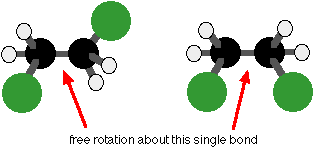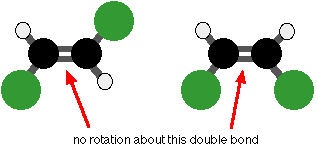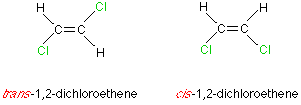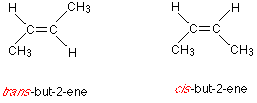
Geometric (cis / trans) isomerism
 المؤلف:
..................
المؤلف:
..................
 المصدر:
LibreTexts Project
المصدر:
LibreTexts Project
 الجزء والصفحة:
.................
الجزء والصفحة:
.................
 12-7-2019
12-7-2019
 4584
4584
Geometric (cis / trans) isomerism
These isomers occur where you have restricted rotation somewhere in a molecule. At an introductory level in organic chemistry, examples usually just involve the carbon-carbon double bond - and that's what this page will concentrate on. Think about what happens in molecules where there is unrestricted rotation about carbon bonds - in other words where the carbon-carbon bonds are all single. The next diagram shows two possible configurations of 1,2-dichloroethane.

These two models represent exactly the same molecule. You can get from one to the other just by twisting around the carbon-carbon single bond. These molecules are not isomers. If you draw a structural formula instead of using models, you have to bear in mind the possibility of this free rotation about single bonds. You must accept that these two structures represent the same molecule:

But what happens if you have a carbon-carbon double bond - as in 1,2-dichloroethene?

These two molecules are not the same. The carbon-carbon double bond won't rotate and so you would have to take the models to pieces in order to convert one structure into the other one. That is a simple test for isomers. If you have to take a model to pieces to convert it into another one, then you've got isomers. If you merely have to twist it a bit, then you haven't!
Drawing structural formulae for the last pair of models gives two possible isomers:
- In one, the two chlorine atoms are locked on opposite sides of the double bond. This is known as the trans isomer. (trans : from latin meaning "across" - as in transatlantic).
- In the other, the two chlorine atoms are locked on the same side of the double bond. This is know as the cis isomer. (cis : from latin meaning "on this side")

The most likely example of geometric isomerism you will meet at an introductory level is but-2-ene. In one case, the CH3 groups are on opposite sides of the double bond, and in the other case they are on the same side.

 الاكثر قراءة في الهايدروكاربونات
الاكثر قراءة في الهايدروكاربونات
 اخر الاخبار
اخر الاخبار
اخبار العتبة العباسية المقدسة


